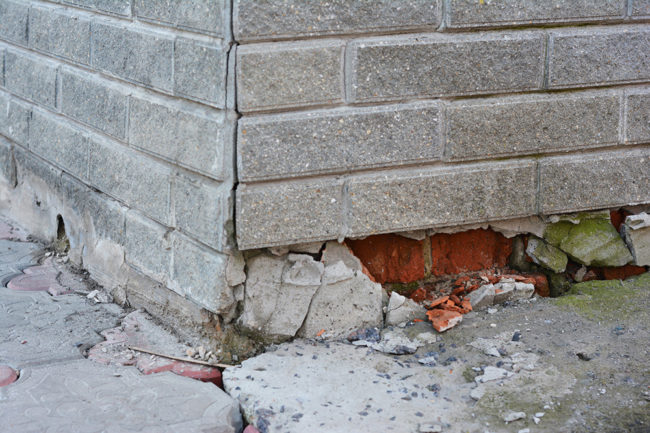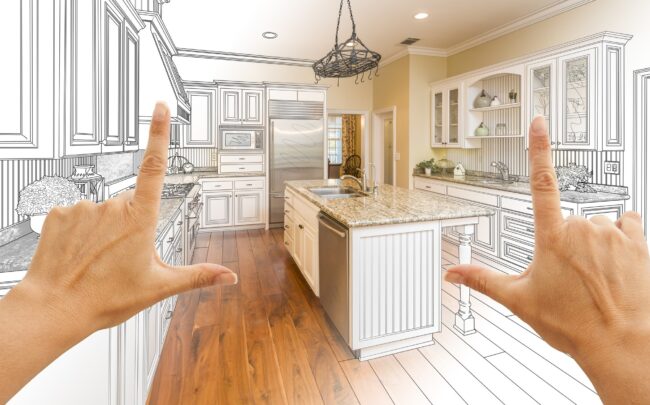The longevity and stability of a structure highly depends on the state of the foundation. It supports the weight of the structure, as well as live and dead loads.
This happens by transferring the weight to the grade below.
For these reasons, contractors compact the soil to increase the weight-bearing capability. However, over time, issues start to come up.
Any foundation problem compromises the integrity of the structure and safety of the occupants. A common issue is foundation settlement.
What Are the Warning Signs?
The worse the cause of the problem is, the worse the actual problem gets. It can take anywhere from a few weeks to years.
Bowed foundation walls and jamming building openings are the first telltale signs.
Other signs include:
- Sloping floors
- Out of level openings
- Change of water flow direction on the floor
- Stair step cracks
What Causes Foundation Settlement?
The direct cause is the live and dead load exerted by the building. However, indirect factors may contribute to or solely cause settlement.
Construction engineers test the soil before breaking ground.
The presence of underground mines, cavities, and tunnels contribute to the settlement. Most urban projects are under or near building foundations due to the high population and limited space. The excavations disturb deep foundations.
Extreme weather changes cause oversaturation, droughts, and permafrost — these compromise soil integrity. Massive flooding or standing water oversaturate the soil. This softens the ground and reverses the compaction.
On the other hand, drought creates pockets in the soil structure due to moisture loss. The soil collapses under the foundation weight to fill the gaps.
Different soil types exhibit varying properties under load, moisture, and temperature fluctuations. Clay absorbs water readily, leading to expansion after saturation. This results in foundation cracking and shifting.
Worse still, in the absence of water, clay shrinks and cracks, leaving gaps for the next expansion cycle. Over time, this leads to extensive foundation settling. Sand, on the other hand, is permeable to water and retains volume and density when saturated.
However, sandy regions tend to be few and far between compared to different soils.
Other causes of foundation settlement include:
- Yielding of adjacent excavations
- Excessive moisture uptake by adjacent vegetation
- Earthquakes
- Underwater and oil extraction
Types of Foundation Settlement
Foundation settlement happens to buildings over soil with weak load-bearing capacity.
Two primary types of settlement exist. Though both emanate from soil settlement, the profile and rate differentiate the types.
Uniform Settlement
This occurs when the foundation sinks at the same rate. This primarily happens for homogenous soil structure across the building rest area. However, it can still happen when the soil is different, but the building exerts varying pressure due to structural design.
Uniform settlement building issues are minimal. Often, the only noticeable signs are sticking doors and windows. The settling foundation may damage underground utility lines such as sewer, water, and power.
Differential Settlement
In this instance, settling occurs at varying rates across the building footprint. Common causes include changing soil types, compaction, loads, and structural profile differences. The sheer distortion results to:
- Cracked walls and glass
- Distorted frames
- Sloping floors
- Jammed doors
- Fixed utilities slip out of alignment, leading to leaks, flooding and power issues
Conventionally, acceptable and tolerable differential settlements are 20mm and 50mm, respectively.
Preventative Measures
All buildings settle naturally as soil characteristics change over time. However, preventative measures slow the onset and progress.
Install a functional drainage system. All features should guide water away from the house.
Clean your gutters and direct spouts away from the foundation and walls. You can also install an impervious strip between the foundation and soil.
Undertake exhaustive soil inspection before construction. Building codes in different areas constitute regulations based on the local soil structure.
If building in permafrost areas, such as Alaska, carefully select the building site. 85% of Alaska has permafrost.
Specialized building techniques exist to allow building erection. For extensive permafrost, use pilings in the foundation.
Control vegetation around the house. Engage a landscaper and contractor on vegetation types and blockers such as root barriers. Some vegetation species, especially trees, use up a lot of water and dehydrate the soil. Examples include the Atlantic White Cedar and Bald Cypress.
Other solutions are pipe piles and helical anchors. However, do note that some issues, such as cracked foundation, do not always imply foundation settlement. Engage a professional foundation repair company for inspection and cost-effective, workable solutions.
Work With Experts to Resolve Foundation Settlement
Most people often confuse foundation settlement for poor workmanship, especially for fixtures. Carpenters and fitters often face blame due to jammed windows and doors, bowed sidings, and cracks.
Though most signs are noticeable, attempts at DIY may make it worse. Settlement ranges from natural shifting to emergencies. You probably won’t realize how serious it really is.
Engage a structural engineer to assess the situation, determine the cause and solutions.












